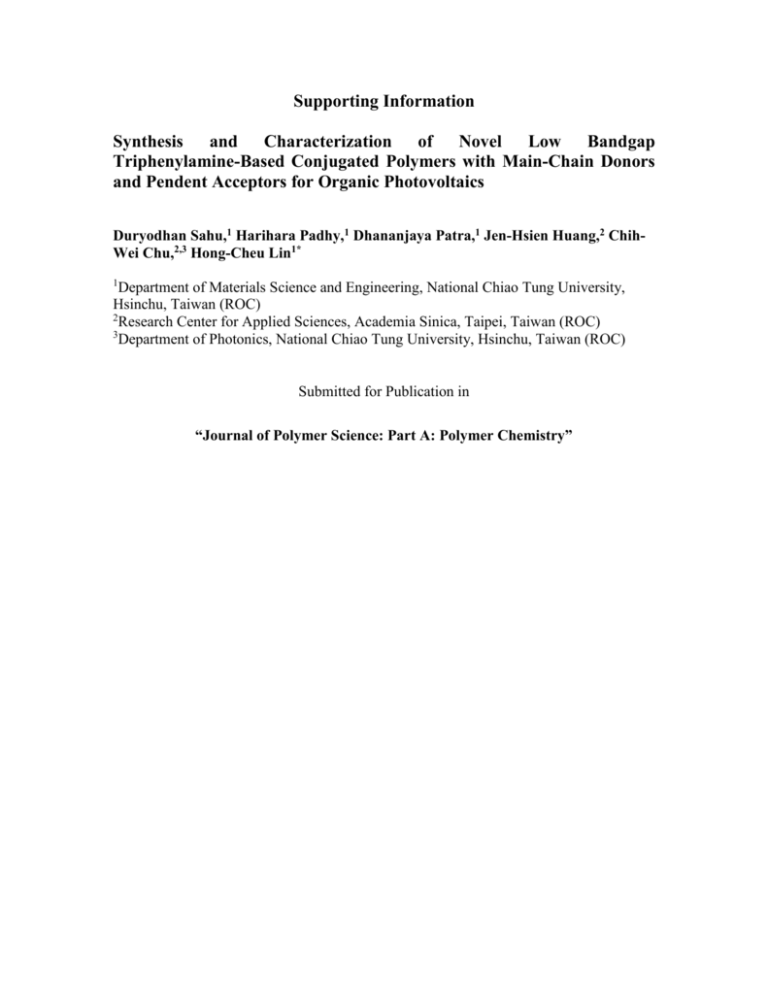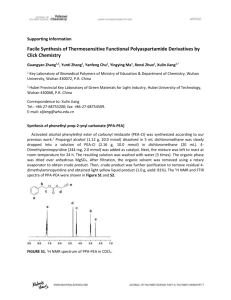POLA_24389_sm_suppinfo
advertisement

Supporting Information Synthesis and Characterization of Novel Low Bandgap Triphenylamine-Based Conjugated Polymers with Main-Chain Donors and Pendent Acceptors for Organic Photovoltaics Duryodhan Sahu,1 Harihara Padhy,1 Dhananjaya Patra,1 Jen-Hsien Huang,2 ChihWei Chu,2,3 Hong-Cheu Lin1* 1 Department of Materials Science and Engineering, National Chiao Tung University, Hsinchu, Taiwan (ROC) 2 Research Center for Applied Sciences, Academia Sinica, Taipei, Taiwan (ROC) 3 Department of Photonics, National Chiao Tung University, Hsinchu, Taiwan (ROC) Submitted for Publication in “Journal of Polymer Science: Part A: Polymer Chemistry” 3-(4-(Bis(4-bromophenyl)amino) phenyl)-2-(thiophen-2-yl)acrylonitrile (1) To a solution of 3.0 g (7.0 mmol) of 4-(bis(4-bromophenyl)amino)benzaldehyde and 1.10 g (9.0 mmol) of 2-(thiophen-2-yl)acetonitrile in 80 mL of dry ethanol:THF (4:1) was added 280 mg of powdered sodium hydroxide in ethanol (10 mL) solution. The reaction mixture was stirred 24 h at room temperature and then diluted with dichloromethane and water. The two phases were separated, and the water phase was extracted twice with dichloromethane. The combined organic extracts were dried over magnesium sulfate and filtered, then the filtrate was evaporated by rotary evaporator and the crude product was purified by column chromatography (silica) using hexane:dichloromethane (5:1) as eluent to yield 3-(4-(bis(4-bromophenyl)amino) phenyl)-2-(thiophen-2-yl)acrylonitrile (1) (3.2 g, 85.7%) as a yellow solid. 1H NMR (300 MHz, CDCl3), δ(ppm): 7.83 (d, J = 9.0 Hz, 2H), 7.67 (s, 1H), 7.63 (dd, J = 1.2 Hz, J = 5.4 Hz, 1H), 7.557.48 (m, 4H), 7.38 (d, J = 3.6 Hz, 1H), 7.14 (t, J = 3.6 Hz, 1H), 7.067.00 (m, 6H). 4,4'-Dibromo-2-nitrobiphenyl (2) 4,4'-Dibromobiphenyl (20 g, 64 mmol), in 300 mL glacial acetic acid was heated (100 o C) to dissolve completely then 90 mL of fuming nitric acid was added dropwise for a period of 30 min. The resulting mixture was further stirred vigorously for 1 h at 100 oC to get a reddish brown precipitate. The reaction mixtures were cooled to room temperature and poured into ice cold water. The precipitate was filtered and washed with excess of water then the obtained product was further purified by recrystalization from ethanol to get a yellow solid (20.30 g, 88.72%). 1H NMR (300 MHz, CDCl3), δ(ppm): 8.03 (d, J = 3 Hz, 1H), 7.75 (dd, J = 9 Hz, J = 3.0Hz 1H), 7.55 (d, J = 9.0 Hz, 2H), 7.30 (d, J = 9 Hz, 2H), 7.15 (d, J = 6 Hz, 2H). 2,7-Dibromocarbazole (3) Mixture of compound 2 (20 gm, 56.02 mmol) and triphenyl phoshpine (36.73 gm, 140.05 mmol) were dissolved in 220 ml of dichlorobenzene and the reaction mixture was refluxed for 12 h. The excess dichlorobenzene ware removed by high vacuum distillation and the residue was purified by column chromatography (silica) using a mixture of hexane:ethyl acetate (7:3) to get a white solid (12.90 g, 70.87%). 1H NMR (300 MHz, CDCl3), δ(ppm): 8.08 (br, 1H), 7.87 (d, J = 8.7 Hz, 2H), 7.56 (d, J = 1.5 Hz, 2H), 7.35 (dd, J =1.8 Hz, J =8.4 Hz, 2H). 1-Hexylheptanol (4) A solution of ethyl formate (10 mL, 123.78 mmol) in dry THF (80 mL) was added dropwise to a fresh solution of hexyl magnesium bromide, which was prepared from 1bromohexane (48.90 ml, 346.59 mmol) and magnesium (10.40 g, 433.24 mmol) in 150 mL dry THF. After then, the reaction mixture was stirred overnight at room temperature. Next, the reaction mixture was quenched by the addition of MeOH, followed by saturated aqueous NH4Cl. The crude compound was extracted three times with ethyl acetate. The combined organic fractions were washed with brine and dried over MgSO4. After removal of the solvent, the residue was purified by recrystalization from acetonitrile to afford 1-hexylheptanol (4) as white solids (21.87 g, 87.94%).1H NMR (300 MHz, CDCl3), δ(ppm): 3.58 (m, 1H), 1.46–1.25 (m, 21H), 0.87 (t, J = 6.4 Hz, 6H). Tridecan-7-yl-4-methylbenzenesulfonate (5) To a mixture of 1-Hexylheptanol (10.0 g, 49.91 mmol), Et3N (17.40 mL, 124.77 mmol) and Me3N·HC1(4.77 g, 49.91 mmol) in CH2Cl2 40 mL at 5 °C, a solution of ptoluenesulfonyl chloride (11.90 g, 62.38 mmol) in dichloromethane (39 mL) was added drop wise over a period of 90 min then the reaction was further stirred for 2 h at room temperature. The reaction mixture was extracted with dichloromethane and washed with water and brine then the organic layer was dried over MgSO4, and concentrated in rotary evaporator. Subsequently, the crude product was further purified by column chromatography (silica) using a mixture of hexane:ethylacetate (9:1) as an eluent to Yield an oil (15.15 g, 85.6%). 1H NMR (300 MHz, CDCl3), δ(ppm): 7.79 (d, J = 8.2 Hz, 2H), 7.32 (d, J = 8.1 Hz, 2H), 4.53 (qt, J = 6.0 Hz, 1H), 2.43 (s, 3H), 1.52 (m, 4H), 1.22 (m, 20H), 0.88 (t, J = 6.9 Hz, 6H). 2,7-Dibromo-9-(tridecan-7-yl)-9H-carbazole (6) 2,7-Dibromo-9-(tridecan-7-yl)-9H-carbazole (4.0 g, 12.30 mmol) and potassium hydroxide powder (3.45 g, 61.50 mmol) were dissolved in 50 mL of DMSO at 60 °C. Then a solution of tridecan-7-yl 4-methylbenzenesulfonate (6.25 g, 18.45 mmol) with 30 mL DMSO was added drop wise through a dropping funnel over 1.5–2 h and stirred overnight. The reaction mixture was cooled to room temperature and poured into 500 mL of water. The crude compound was extracted with EA and washed with brine. The combined organic layer was dried over MgSO4 and concentrated in rotary evaporator. The crude compound was purified by column chromatography (silica) using hexane as an eluent to give a white solid. (4.62 g, 74.03%). 1H NMR (300 MHz, CDCl3), δ(ppm): 7.90 (br, 2H), 7.70 (br, 1H), 7.54 (br, 1H), 7.33 (br, 2H), 4.42 (m, 1H), 2.19 (m, 2H), 1.91 (m, 2H), 1.15 (m, 16H), 0.97 (br, 2H), 0.83 (t, J = 6.3 Hz, 6H). 10-(Tridecan-7-yl)-10H-phenothiazine (7) The synthesis of compound 7 was followed by a procedure similar to that described for compound 6. 10H-phenothiazine (5.0 g, 25.09 mmol ) and potassium hydroxide powder (7 g, 125.45 mmol) were dissolved in 70 mL of DMSO at 60 °C. Then a solution of tridecan-7-yl 4-methylbenzenesulfonate (13.34 g, 18.45 mmol) with 30 mL DMSO was added drop wise through a dropping funnel over 1.5–2 h and stirred overnight. The reaction mixture was cooled to room temperature and poured into 500 mL of water. The crude compound was extracted with EA and washed with brine. The combined organic layer was dried over MgSO4 and concentrated in rotary evaporator. The crude compound was purified by column chromatography (silica) using hexane as an eluent to give a white solid. (7.4 g, 77.3 %). 1H NMR (300 MHz, CDCl3), δ(ppm): 7.127.06 (m, 4H), 6.926.85 (m, 4H), 3.64 (m, 1H), 2.132.01 (m, 2H), 1.871.74 (m, 2H), 1.551.25 (m, 16H), 0.85 (t, J = 6.6 Hz, 6H). 3,7-Dibromo-10-(tridecan-7-yl)-10H-phenothiazine (8) A solution of 5.13 g (28.82 mmol) of N-bromosuccinimide (NBS) in10 mL of DMF was added dropwise to a solution of 5.0 g (13.10 mmol) of compound 7 in 40 mL of DMF under nitrogen atmosphere at 5 ◦C for a period of 30 min. After being stirred for 24 h at room temperature, 100 mL of water was added into a reaction mixture then extracted with 100 mL of ethyl acetate three times followed by a little brine. The organic extracts were dried over anhydrous MgSO4 and the solvent was removed by rotary evaporator. The crude product was purified by column chromatography (silica) using hexane as an eluent to yield light yellow solid (6.20 g, 88%). 7.217.18 (m, 4H), 6.74 (d, J = 9 Hz, 2H) 3.55 (m, 1H), 1.991.94 (m, 2H), 1.941.73 (m, 2H), 1.491.25 (m, 16H), 0.86 (t, J = 6.9 Hz,6H). Figure S1. TGA thermograms of polymers (PCAZCN, PPTZCN, and PDTPCN). Figure S2. Cyclic voltammograms of polymers (PCAZCN, PPTZCN, and PDTPCN). Figure S3. External quantum efficiency (EQE) of polymer solar cells containing polymers blends (PCAZCN, PPTZCN, and PDTPCN):PC71BM in 1:1weight ratio. Figure S4. AFM images of polymer blends (a) PCAZCN (b) PPTZCN and (c) PDTPCN blended with PC61BM in 1:1 weight ratio.






